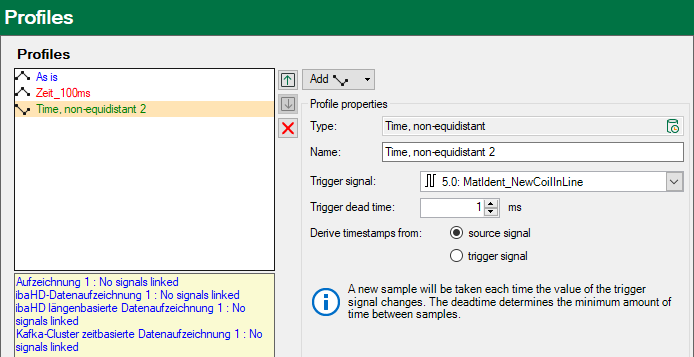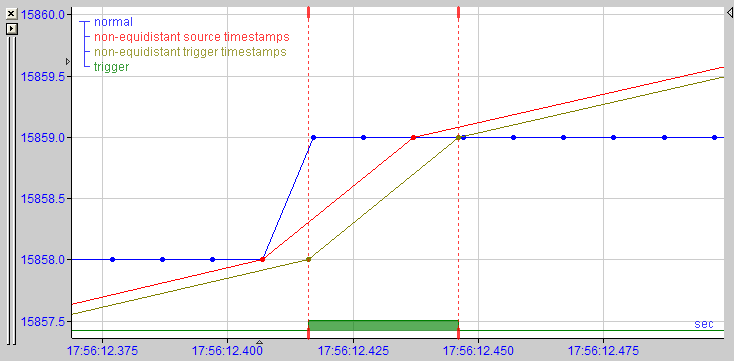This profile type has been developed for specific requirements. It is suitable for situations with an controlled irregular occurrence of measurement data, depending on the process event. It is also suitable, for instance, if you just want “snapshots” of the process data to be triggered by a control signal.

Profile properties
Type
Display of the profile type with the appropriate types of data store (symbols)
Name
Enter an unambiguous and understandable name here.
Trigger signal
Select a signal from the dropdown list to be used as trigger for writing samples in the data file.
Every time the value of the trigger signal changes, a new sample will be stored.
If you use an analog value for triggering, samples are with high probability recorded continuously unless the analog value remains 100 % constant over periods where no sample should be stored. Using a digital signal as trigger will store samples with every rising/falling edge, as shown in the figure below.

Trigger dead time
The trigger dead time determines the minimum period between the samples. Trigger events that occur during the trigger dead time are ignored.
Derive timestamps from source signal/trigger signal
If the trigger signal and source signal have different time bases, you can choose which timestamps to use for the non-equidistant signal. “Source signal” is every signal assigned to this profile.
Explanation
The screenshot below shows another example of the difference between the two options.

The blue signal is the source signal. The green digital signal is the trigger signal. The source signal is sampled at 10 ms. The trigger signal is sampled at 1 ms. You can see that the trigger value changes at a time that does not correspond with the sample of the source signal.
The red signal is the non-equidistant signal that uses the timestamps from the source signal. You can see that the sample points of the red signal correspond with the sample points of the original signal. If you choose source signal timestamps, the timestamp will be smaller or equal to the trigger timestamp.
The brown signal is the non-equidistant signal that uses the timestamps of the trigger signal. You can see that the sample points of the brown signal correspond with the sample points of the original signal moved to the trigger timestamps.
Both options have advantages as well as disadvantages.
Source timestamps
The advantage of source timestamps is that the original samples are used. The disadvantage is that if you have multiple source signals with different time bases, the sample points of the generated non-equidistant signals will have different timestamps. If you subsequently perform calculations based on these non-equidistant signals, they will be converted to equidistant signals and the calculations will be performed on equidistant signals.
Trigger timestamps
The disadvantage of trigger timestamps is that the original sample points are moved. The advantage is that all non-equidistant signals generated by the same profile have the same timestamps irrespective of their original time bases. Calculations are performed on the non-equidistant signals, and as result, a non-equidistant signal is given.